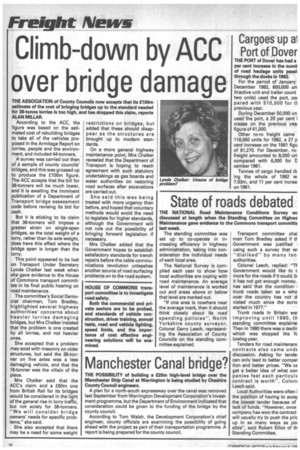Climb-down by ACC over bridge damage
Page 12

If you've noticed an error in this article please click here to report it so we can fix it.
THE ASSOCIATION of County Councils now accepts that its £100m estimate of the cost of bringing bridges up to the standard needed for 38-tonne lorries is too high, and has dropped this claim, reports ALAN MILLAR.
According to the ACC, the figure was based on the estimated cost of rebuilding bridges to take all of the vehicles proposed in the Armitage Report on lorries, people and the environment, and included 44-tonners.
A survey was carried out then of a sample of county councils' bridges, and this was grossed up to produce the £100m figure. The ACC accepts that the bill for 38-tonners will be much lower, and it is awaiting the imminent publication of a Department of Transport bridge assessment code before revising its bid for cash.
But it is sticking to its claim that 38-tonners will impose a greater strain on single-span bridges, as the total weight of a. lorry, rather than its axle weight, does have this effect where the bridge span is longer than the lorry.
This point appeared to be lost on Transport Under Secretary Lynda Chalker last week when she gave evidence to the House of Commons transport committee in its final public hearing on road maintenance.
The committee's Social Democrat chairman, Tom Bradley, highlighted several highway authorities' concerns about heavier lorries damaging bridges, but Mrs Chalker insisted that the problem is one created by all lorries, and not heavier ones.
She accepted that a problem may exist with masonry on older structures, but said the 38-ton damaging vehicle, and that the ner on five axles was a less piece.
Mrs Chalker said that the ACC's claim and a £60m one from British Rail for its bridges would be considered in the light of the general rise in lorry traffic, but not solely for 38-tonners. "We will consider bridge owners' needs for specific problems," she said.
She also accepted that there may be a need for some weight restrictions on bridges, but added that these should disappear as the structures are brought up to modern standards.
On a more general highway maintenance point, Mrs Chalker revealed that the Department of Transport is hoping to reach agreement with such statutory undertakings as gas boards and water authorities on restoring road surfaces after excavations are carried out.
She said this was being treated with more urgency than before, and hoped that voluntary methods would avoid the need to legislate for higher standards, although the Government will not rule out the possibility of bringing forward legislation if necessary.
Mrs Chalker added that the Government hopes to establish satisfactory standards for trench repairs before the cable communications revolution unleashes another source of road surfacing problems on to the road system.












































































































